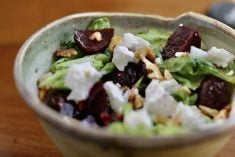Do you need a summertime activity for the children who are home from
school?
Kids love to bake and so making this sweet bread recipe can be one fun
activity. I tried it with my grandson, Ben. He enjoyed getting his
hands into the dough, making the doodle shapes and of course eating the
finished product.
Sweet doodle bread
Dough:
3-31/2 cups all-purpose 750-875 mL
flour
1/2 cup rolled oats (old- 125 mL
Read Also

Communication key to bridging generation gap
Each generation is shaped by the predominant forces at play during their formative years. Acknowledging these influences can improve communication among the generations.
fashioned or quick)
1 package Fleischmann’s
Quick-Rise Instant Yeast
(8 g /21/4 teaspoons/11 mL)
1 teaspoon salt 5 mL
11/4 cups water 300 mL
3 tablespoons honey 45 mL
2 tablespoons butter or 30 mL
margarine, cut up
Topping:
2 tablespoons butter or 30 mL
margarine
1/3 cup sugar 75 mL
3/4 teaspoon ground 3 mL
cinnamon
In a large bowl, combine 11/2 cups (375 mL) flour, oats, undissolved
yeast and salt. Heat water, honey and butter until warm (120-130
F/50-55 C). Gradually stir into dry ingredients. Stir in enough
remaining flour to make soft dough. Knead on lightly floured surface
until smooth and elastic, about five minutes. Cover and let rest for 10
minutes.
Divide dough into 16 equal pieces; roll each to a 20 inch (50 cm) rope.
On greased baking sheets, form ropes into desired shapes, such as
letters, numbers, knots and twists. Cover and let rise in warm,
draft-free place until doubled in size, about 30 to 40 minutes.
Brush doodles with melted butter. Combine sugar and cinnamon, then
sprinkle evenly over tops. Bake at 375 F (190 C) for 15 to 20 minutes
or until golden brown. Serve warm.
To make a variety of doodle shapes, follow directions below:
- Pretzels: Roll dough pieces to 16 in. (40 cm) ropes. Curve each to
form a circle, crossing ends over at top. Twist ends once and pull
crossed ends over bottom of circle.
- Twists: Roll dough pieces to 12 in. (30 cm) ropes. Fold each in half
and twist five times. Pinch ends to seal.
- Knots: Roll dough to 10 in. (25 cm) ropes. Tie each loosely in centre
to form a knot.
- Holiday shapes: Form ropes into hearts, shamrocks, pumpkins, bells or
candy canes, as desired.
– Source: Fleischmann’s Yeast
Do saskatoons fight disease?
Dear TEAM: A recent article I read extolled blueberries’ antioxidant
power. It said that power comes from anthocyanins, the pigments that
give blueberries their colour. It also says that blueberries contain
compounds that can prevent urinary tract infections.
Are saskatoon berries equal to blueberries? We have tame trees.
Blueberries are not that widely available here and are expensive to
buy. I freeze and can our saskatoon berries. – M.L., Stockholm, Sask.
Dear M.L.: A recent study by Dr. David Kitts at the University of
British Columbia showed that saskatoon berries contain antioxidants,
known to protect against certain diseases. The three-year study by
Kitts shows saskatoons are comparable in antioxidant activity to
blueberries, blackberries and grape seed extract. The saskatoon
varieties studied were Smokie and Thiessen.
The research was conducted in conjunction with Riverbend Plantation
Inc. of Saskatoon and was supported by the Saskatchewan Agriculture
Development Fund.
Because cranberries, blueberries and other fruits have been linked to
the prevention of urinary tract infections, we might assume saskatoon
berries would also. However, I haven’t been able to find research or
studies to confirm or deny that.
Recipe request
Dear A.M., Fairview, Alta.: For the quark cheese recipes that you
requested, please let us know your address so we can forward additional
quark cheese recipes. One recipe was printed in the July 18 Western
Producer.
Table salt
Dear TEAM: Is sea salt healthier for you than regular salt? If you use
sea salt does your body get enough iodine? Salt free diets are
recommended for high blood pressure patients. Would they be able to use
sea salt? – S. N., Eaton, Sask.
Dear S.N.: Salt is salt. Whether the salt crystal is tiny or large,
mined from the earth or the sea, it’s all sodium chloride. All salts at
one time came from a sea. The oceans that once covered the earth left a
generous supply of salt beds and underground deposits.
To answer your questions, one kind of salt is not healthier than the
other and salt free diets would eliminate all kinds of salt.
By eliminating all table salt, one could limit iodine, which means some
people could risk developing goiters. Seafood provides a considerable
amount of iodine. The quantity in natural sources varies broadly,
depending upon the iodine content of the soil.
- Table salt: Sometimes called iodized salt, this is the salt used in
most households. Shaped like tiny cubes, table salt is finely ground
and mixed with calcium silicate to prevent caking or clumping. Table
salt’s source is not identified; it can be mined or be from the sea.
- Kosher salt: This coarse, flaky salt is used by many food
professionals. It consists of many cubes of salt stuck together. With
its large surface area it can absorb more moisture than a similar sized
cubic salt crystal. This makes it ideal for curing meat and fish. Other
uses are on pretzels and on the rim of drink glasses.
- Sea salt: This is made from evaporated sea water that has been
purified. It comes in many forms and can be coarse or fine.
- Rock salt: This is not edible. It is used for freezing ice cream.
- Pickling salt: This salt is free of additives and iodine. The iodine
in regular table salt can cause pickles to darken. Anticaking agents
used in table salt can cause a cloudy appearance in pickles.
Alma Copeland is a home economist from Rosetown, Sask., and one of four
columnists comprising Team Resources. Send correspondence in care of
this newspaper, Box 2500, Saskatoon, Sask., S7K 2C4.














